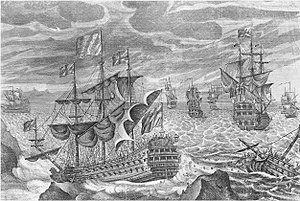HMS Romney (1694)
 Sir Cloudesly Shovel in the Association with the Eagle, Romney and the Firebrand, lost on the rocks of Scilly | |
| History | |
|---|---|
| Name | HMS Romney |
| Ordered | 16 November 1693 |
| Builder | Johnson, Sir Henry Johnson, Blackwall Yard |
| Launched | 23 October 1694 |
| Fate | Wrecked, 26 October 1707 |
| General characteristics [1] | |
| Class and type | 50-gun fourth rate ship of the line |
| Tons burthen | 683 41⁄94 bm |
| Length | 130 ft 0.5 in (39.6 m) (gundeck) 109 ft (33.2 m) (keel) |
| Beam | 34 ft 4 in (10.5 m) |
| Depth of hold | 13 ft 7 in (4.1 m) |
| Propulsion | Sails |
| Sail plan | Full-rigged ship |
| Complement | 230 in wartime, 160 in peace |
| Armament |
|
HMS Romney was a 50-gun fourth rate ship of the line of the Royal Navy, ordered to be built by commercial contract by Sir Henry Johnson on 16 November 1693 (along with her sistership, the Colchester - the contract for both ships was signed on 23 February 1694), and both ships were launched at the contractor's Blackwall Yard on 23 October 1694. The Romney was commissioned in 1695 under Captain Edmund Loades, for service in the Mediterranean.[1][2]
Commanded by Captain William Coney,[3] Romney was wrecked on the Bishop & Clerks Rocks, off the Scilly Isles on 26 October 1707[1][4] when a disastrous navigational error sent Admiral Sir Cloudesley Shovell's fleet through dangerous reefs while on their way from Gibraltar to Portsmouth. Four ships (Romney, Association, Firebrand and Eagle) were lost, with nearly 2,000[5] sailors. Romney hit Bishop Rock and went down with all but one of her crew. The sole survivor was George Lawrence, who had worked as a butcher before joining the crew of Romney as quartermaster.[6] The Scillies naval disaster was one of the greatest maritime disasters in British history. It was largely as a result of this disaster that the Board of the Admiralty instituted a competition for a more precise method to determine longitude.
Notes
- ^ a b c Rif Winfield, British Warships in the Age of Sail: 1603-1714, p.134.
- ^ "British Fourth Rate ship of the line 'Romney' (1694)". Threedecks. Retrieved 17 November 2019.
- ^ James Herbert Cooke, The Shipwreck of Sir Cloudesley Shovell on the Scilly Islands in 1707, From Original and Contemporary Documents Hitherto Unpublished, Read at a Meeting of the Society of Antiquaries, London, 1 Feb. 1883
- ^ Ships of the Old Navy, Romney.
- ^ Sobel, Dava, Longitude: The True Story of a Lone Genius Who Solved the Greatest Scientific Problem of His Time, Fourth Estate Ltd., London 1998, p. 6, ISBN 1-85702-571-7
- ^ HMS Association (+1707) on www.wrecksite.eu
References
- Lavery, Brian (2003) The Ship of the Line – Volume 1: The development of the battlefleet 1650-1850. Conway Maritime Press. ISBN 0-85177-252-8.
- Michael Phillips. Romney (54) (1694). Michael Phillips' Ships of the Old Navy. Retrieved 7 November 2008.
- Winfield, Rif (1997), The 50-Gun Ship: A Complete History. Chatham Publishing (1st edition); Mercury Books (2nd edition 2005). ISBN 1-845600-09-6.
- Winfield, Rif (2009) British Warships in the Age of Sail: 1603-1714: Design, Construction, Careers and Fates. Seaforth Publishing. ISBN 978-1-84832-040-6.
